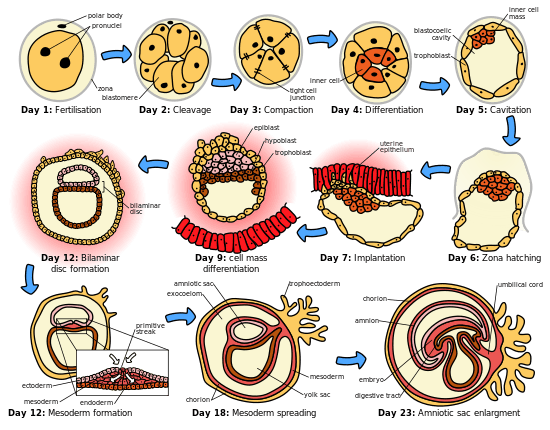Zona pellucida
| Zona pellucida | |
|---|---|
 Human ovum: The zona pellucida is seen as a thick clear girdle surrounded by the cells of the corona radiata. | |
| Identifiers | |
| MeSH | A05.360.490.690.950 |
| Dorlands /Elsevier | z_01/12869767 |
| FMA | 18674 |
The zona pellucida (plural zonae pellucidae, also egg coat or pellucid zone) is a glycoprotein layer surrounding the plasma membrane of mammalian oocytes. It is a vital constitutive part of the oocyte. The zona pellucida first appears in unilaminar primary oocytes. It is secreted by both the oocyte and the follicular cells. The zona pellucida is surrounded by the cumulus oophorus. The cumulus is composed of cells that care for the egg when it is emitted from the ovary.[1]
This structure binds spermatozoa, and is required to initiate the acrosome reaction. In the mouse (the best characterised mammalian system), the zona glycoprotein, ZP3, is responsible for sperm binding, adhering to proteins on the sperm plasma membrane (GalT). ZP3 is then involved in the induction of the acrosome reaction, whereby a spermatozoon releases the contents of the acrosomal vesicle. The exact characterisation of what occurs in other species has become more complicated as further zona proteins have been identified.[2][3]
In humans, five days after the fertilization, the blastocyst performs zona hatching; the zona pellucida degenerates and decomposes, to be replaced by the underlying layer of trophoblastic cells.
The zona pellucida is essential for oocyte death and fertilization.
In some older texts, it has also been called zona striata and stratum lucidum[4] (not to be confused with the stratum lucidum of the skin).
Immunocontraception
Glycoproteins in ZP1, 2, 3 and 4 are targets for immunocontraception in mammals.
In non-mammalian animals, the zona pellucida (called vitelline layer) plays an important role in preventing cross-breeding of different species, especially in species that fertilize outside of the body (e.g. fish).
The zona pellucida is commonly used to control wildlife population problems by immunocontraception. When the zona pellucida of one animal species is injected into the bloodstream of another, it results in sterility of the second species due to immune response. This effect can be temporary or permanent, depending on the method used. In New Jersey, immunocontraception using porcine zona pellucida has been trialled for the control of deer populations, for example using the products "SpayVac" and "GonaCon".[5]
Zona pellucida glycoproteins
There are four major zona pellucida glycoproteins, termed ZP1-4. ZP1, ZP3 and ZP4 bind to capacitated spermatozoa and induce the acrosome reaction. Successful fertilization depends on the ability of sperm to penetrate the extracellular matrix that surrounds the egg. In the mouse:
- ZP3 allows species-specific sperm binding
- ZP2 mediates subsequent sperm binding
- ZP1 cross-links ZP2 and ZP3.
Data with native human protein are not currently available.
Additional images
-

First stages of segmentation of a mammalian ovum
-

Section of vesicular ovarian follicle of cat, x 50
-

The initial stages of human embryogenesis
See also
References
- ↑ Gilbert, Scott (2013). Developmental Biology. Sinauer Associates Inc. p. 123. ISBN 9781605351926.
- ↑ Conner, SJ; Hughes, DC (2003). "Analysis of fish ZP1/ZPB homologous genes--evidence for both genome duplication and species-specific amplification models of evolution". Reproduction 126 (3): 347–52. doi:10.1530/rep.0.1260347. PMID 12968942.
- ↑ Conner, S.J.; Lefièvre, L; Hughes, DC; Barratt, CL (2005). "Cracking the egg: Increased complexity in the zona pellucida". Human Reproduction 20 (5): 1148–52. doi:10.1093/humrep/deh835. PMID 15760956.
- ↑ Wigham, J. T. (1936). "Endometrioma and other similar abnormalities". Irish Journal of Medical Science 11 (6): 279–80. doi:10.1007/BF02956856.
- ↑ "Community-Based Deer Management". New Jersey Department of Environmental Protection. 24 September 2014. Retrieved 8 July 2015.
Further reading
- Bork, Peer; Sander, Chris (1992). "A large domain common to sperm receptors (Zp2 and Zp3) and TGF-β type III receptor". FEBS Letters 300 (3): 237–40. doi:10.1016/0014-5793(92)80853-9. PMID 1313375.
- Oehninger, Sergio (2003). "Biochemical and functional characterization of the human zona pellucida". Reproductive BioMedicine Online 7 (6): 641–8. doi:10.1016/S1472-6483(10)62086-X. PMID 14748962.
- Boja, E. S.; Hoodbhoy, T; Fales, HM; Dean, J (2003). "Structural Characterization of Native Mouse Zona Pellucida Proteins Using Mass Spectrometry". Journal of Biological Chemistry 278 (36): 34189–202. doi:10.1074/jbc.M304026200. PMID 12799386.
- Bagnell C (2005). "Animal Reproduction". Rutgers University Department of Animal Sciences.
- Jovine, Luca; Darie, Costel C.; Litscher, Eveline S.; Wassarman, Paul M. (2005). "Zona Pellucida Domain Proteins". Annual Review of Biochemistry 74: 83–114. doi:10.1146/annurev.biochem.74.082803.133039. PMID 15952882.
- Monné, Magnus; Han, Ling; Jovine, Luca (2006). "Tracking Down the ZP Domain: From the Mammalian Zona Pellucida to the Molluscan Vitelline Envelope". Seminars in Reproductive Medicine 24 (4): 204–16. doi:10.1055/s-2006-948550. PMID 16944418.
- Wassarman, P. M. (2008). "Zona Pellucida Glycoproteins". Journal of Biological Chemistry 283 (36): 24285–9. doi:10.1074/jbc.R800027200. PMC 2528931. PMID 18539589.
- Wassarman, Paul M.; Litscher, Eveline S. (2008). "Mammalian fertilization:the eggs multifunctional zona pellucida". The International Journal of Developmental Biology 52 (5–6): 665–76. doi:10.1387/ijdb.072524pw. PMID 18649280.
- Monné, Magnus; Han, Ling; Schwend, Thomas; Burendahl, Sofia; Jovine, Luca (2008). "Crystal structure of the ZP-N domain of ZP3 reveals the core fold of animal egg coats". Nature 456 (7222): 653–7. doi:10.1038/nature07599. PMID 19052627.
- Han, Ling; Monné, Magnus; Okumura, Hiroki; Schwend, Thomas; Cherry, Amy L.; Flot, David; Matsuda, Tsukasa; Jovine, Luca (2010). "Insights into Egg Coat Assembly and Egg-Sperm Interaction from the X-Ray Structure of Full-Length ZP3". Cell 143 (3): 404–15. doi:10.1016/j.cell.2010.09.041. PMID 20970175.
External links
- Histology image: 18404loa – Histology Learning System at Boston University - "Female Reproductive System: ovary, cumulus oophorus "
- Histology image: 14805loa – Histology Learning System at Boston University - "Female Reproductive System: ovary, multilaminar primary follicle"
- Anatomy photo: Reproductive/mammal/ovary2/ovary7 - Comparative Organology at University of California, Davis - "Mammal, canine ovary (LM, High)"
- Image at um.edu.mt
- Image at um.edu.mt
| ||||||||||||||||||||||||||||||||||||||||||||||||||||||||||||||||||||||